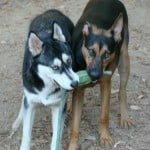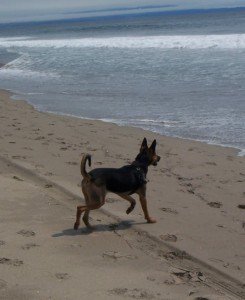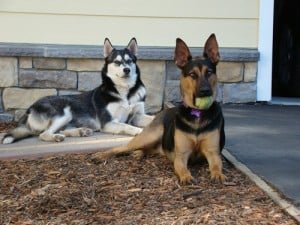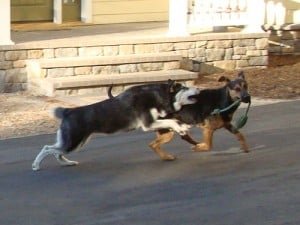 Last week was quiet on the Wild Dingo blogosphere. I was deep into a mind-body yoga teacher training program with Seane Corn, a leading national Vinyasa yoga instructor. There isn't enough room here on Wild Dingo to write about the brilliance of her theories and practice except to dribble a little bit into the application of dog behavior.
Last week was quiet on the Wild Dingo blogosphere. I was deep into a mind-body yoga teacher training program with Seane Corn, a leading national Vinyasa yoga instructor. There isn't enough room here on Wild Dingo to write about the brilliance of her theories and practice except to dribble a little bit into the application of dog behavior.
In the mind-body yoga experience, we are taught that our bodies have memory--cellular memory. Each experience creates memory in our bodies on a physical, cellular level. A few years ago, I experienced a severe head injury due to a bike racing crash. For weeks, I told everyone it was no big deal. On a conscious level, I truly didn't feel emotionally traumatized, and I looked forward to when I could ride a bike again. A week later when I put my leg over the top tube and crawled up on the saddle for a stationary training workout, I looked down at the top tube and a wave of panic and terror came over me and hit me in the stomach so hard, I nearly fell off the saddle and vomited. I burst into tears. The top tube triggered the fear I had forgotten. This makes perfect sense when understanding the biography of the body. What I consciously remembered about the actual accident was glancing down at the top tube and thinking that my entire titanium frame oddly felt like rubber, completely unstable and unsafe. I remembered the physical sensation of the instability, but I never remembered the fleeting yet oh-so-concentrated fear it created, possibly because it happened so fast that my consciousness could only process and remember the physical feeling. There was no time to be aware of the panic it was creating. A week later, the simple glance at the top tube while my body was in a relaxed riding position was all it took to trigger and release the fear that had been dormant in my body. This is an example of a short-lived impact of a biographical incident on my body's biology. But, consider for a moment how any one incident or repeated incident can impact a person's biology for the long term, which can lead to long-term tension, stress and anxiety and eventually to behaviors such as rage, over-eating, depression, violence and so-forth. When you can consider how biography and biology works in a human being, you can begin to understand the quarky behaviors of a rescued dog are the result of its biography.
Biography and Biology in Light of Dog Behavior
 Today's dog behaviorist work on the notion that dogs live in the present and that they don't think about the past or the future. Yet, if that is true, I must question why there are so many dogs with undesirable behaviors such as continued barking, biting, toy or food possession, handler aggression, dog aggression, people aggression, cowering, chewing, house destruction, suddenly un-housebroken, obsessive/compulsive behaviors and more. These behaviors must be learned for they don't present themselves in nature. Behaviorists often dismiss a dog's past experience and decide that the "why" is unimportant. Yet, time and again, a dog's body will tell you when something has triggered his tension, stress and anxiety. When cued by a person, place or thing that have caused stress in the past, a dog's body will become tense, and possibly show low levels of anxiety, a precursor to whatever undesirable behavior that exists today. His body adapts to these triggers and learns to behave consistently whenever exposed to those cues or triggers. Sometimes, the behavior occurs so quickly that the precursor display of anxiety is hard to catch. The more the dog gets to practice the undesirable behavior cued by a trigger, the better he becomes at doing the behavior more quickly and automatically.
Today's dog behaviorist work on the notion that dogs live in the present and that they don't think about the past or the future. Yet, if that is true, I must question why there are so many dogs with undesirable behaviors such as continued barking, biting, toy or food possession, handler aggression, dog aggression, people aggression, cowering, chewing, house destruction, suddenly un-housebroken, obsessive/compulsive behaviors and more. These behaviors must be learned for they don't present themselves in nature. Behaviorists often dismiss a dog's past experience and decide that the "why" is unimportant. Yet, time and again, a dog's body will tell you when something has triggered his tension, stress and anxiety. When cued by a person, place or thing that have caused stress in the past, a dog's body will become tense, and possibly show low levels of anxiety, a precursor to whatever undesirable behavior that exists today. His body adapts to these triggers and learns to behave consistently whenever exposed to those cues or triggers. Sometimes, the behavior occurs so quickly that the precursor display of anxiety is hard to catch. The more the dog gets to practice the undesirable behavior cued by a trigger, the better he becomes at doing the behavior more quickly and automatically.
It can be easy or difficult to read anxiety in your dog's body, but once you figure it out, then the real behavior change can occur. Also, knowing a dog's biography and what triggers tension, stress and anxiety in its body can make behavioral change a lot easier as it is easier to anticipate his behavioral reaction around the things you know may have caused him to be fearful in the past.
Biography becoming the biology is also very much apparent in breeding dogs. Dogs that are bred in certain blood lines for specific activities are a perfect example of biography becoming the biology. People choose a dog from a blood line because a working gene is present in its body to perform a specific task. The blood line/DNA in a dog's body is as much its biography as it is his biology. Before ANY experience contributes to our own biography as infant humans, we are born to a certain body, race, sex, culture, propensity to disease, etc., that is very much our biography. The same is true with dogs. And every biographical experience after what we and our dogs are born with exists in our own bodies and our dog's body and becomes part of the biology. So biology is not only affected by event biography, but it is also affected by genetic biography.
 Working with Loki has taught me so much about rebuilding his confidence and ego. When Loki came to me, he had been through three homes in the states and one in Taiwan. I'd been told he'd been abused and abandoned. But that's it. He had a tremendous amount of fear in him. Everything and anything would trigger his barking, aggression, and handler aggression (meaning whoever was holding his leash, usually me). It took me a year to figure out his triggers, the things that make, or rather made, him fearful, anxious which would then escalate into aggression. His rigid body, a low grumble or a high pitched whine will tell me quickly that he's uncomfortable. It's at that time I look around and figure out what's new to him and quickly take action to turn his tension into calm, happy feelings.
Working with Loki has taught me so much about rebuilding his confidence and ego. When Loki came to me, he had been through three homes in the states and one in Taiwan. I'd been told he'd been abused and abandoned. But that's it. He had a tremendous amount of fear in him. Everything and anything would trigger his barking, aggression, and handler aggression (meaning whoever was holding his leash, usually me). It took me a year to figure out his triggers, the things that make, or rather made, him fearful, anxious which would then escalate into aggression. His rigid body, a low grumble or a high pitched whine will tell me quickly that he's uncomfortable. It's at that time I look around and figure out what's new to him and quickly take action to turn his tension into calm, happy feelings.
When I first got him, I'd take him to the dog park, and he behaved fairly well for the most part, but he would exhibit aggressive behaviors on leashed dog walks time and again. So I looked for a trainer to help. In the beginning of his training, he'd panic and quickly get aggressive for which I'd have to handle through correction as the trainer had taught me. But in time, I quickly found out it was far better to catch his anxiety before it turned into aggression, redirect him to perform for me so he could be rewarded and feel good, rather than wait until the anxiety escalated to aggression, for which he would receive a correction.
 A few months ago, I'd been walking Loki and Juno downtown to get him used to people, runners, bikers, leashed/unleashed dogs, loud car noises and unfamiliar locations. He'd been doing fine but then he spotted two very large Great Danes. His body grew rigid and he grumbled and whined. The Dane's walkers saw this and graciously walked away from me. I did the same; I turned around, walked him away from the Danes until he grew calm. Then I turned around and walked toward the Danes and praised his calm behavior. We came up to three or four feet of the Danes and had a pleasant conversation with the owners all the while Loki was calm and confident. If I hadn't caught his anxiety, it would have escalated into a barking, growling and an aggressive mess which would warrant a correction.
A few months ago, I'd been walking Loki and Juno downtown to get him used to people, runners, bikers, leashed/unleashed dogs, loud car noises and unfamiliar locations. He'd been doing fine but then he spotted two very large Great Danes. His body grew rigid and he grumbled and whined. The Dane's walkers saw this and graciously walked away from me. I did the same; I turned around, walked him away from the Danes until he grew calm. Then I turned around and walked toward the Danes and praised his calm behavior. We came up to three or four feet of the Danes and had a pleasant conversation with the owners all the while Loki was calm and confident. If I hadn't caught his anxiety, it would have escalated into a barking, growling and an aggressive mess which would warrant a correction.
Loki taught me that he learns much better through positive reinforcement than punishment or correction. He also taught me that certain things will trigger his fears. In the beginning, leashes, chains, new collars all triggered his anxiety to fear aggression. In February, when I was dismantling some party decorations, I discovered long sticks or poles (used for hanging flags) trigger his fears. As soon as he saw a pole, he backed up in fear and his body grew tense. I tested Juno with the same pole and she was indifferent to it, not afraid at all. I instantly knew I had to desensitize him to that and showed him the pole and praised and pet him calmly. It's nice to see that though Loki's early biography still exists in his body, he is adopting a new biography and is learning to change certain behavioral reactions simply through the release of tension around the things that trigger him.
Of course dogs don't actually live in their past lives, but their bodies certainly do. To understand this is the first step to help them release tension under their triggers by building their ego and confidence when they are exhibiting calm, relaxed behavior. Additionally, if you ever begin to train a dog using his prey/play drive, you will quickly understand that he can think into the future by anticipating his drive satisfaction (obtaining the prey item). But that's a whole other chapter to this story. To me, it is perfectly comprehensible that a dog has a sense of past, present and future simply by the behavior he is exhibiting in the present.
 Today, Loki is very calm and confident downtown among all sorts of distractions. He's friendly with everyone and exhibits no aggression at all. We still have some unusual anxious behaviors to fine-tune, such as anxiety in car rides. I'm almost certain his fears stem from being abandoned by car. I can't punish him for his fears, but I can redirect and reward him with simple performed tasks and keep desensitizing him to car rides.
Today, Loki is very calm and confident downtown among all sorts of distractions. He's friendly with everyone and exhibits no aggression at all. We still have some unusual anxious behaviors to fine-tune, such as anxiety in car rides. I'm almost certain his fears stem from being abandoned by car. I can't punish him for his fears, but I can redirect and reward him with simple performed tasks and keep desensitizing him to car rides.
Working with rescue dogs is never easy because they've been abandoned or surrendered most likely because of their odd behavior patterns. But if you have a good understanding of how a dog's biography can become part of his biology and behavior, it becomes much easier to be compassionate about the undesirable behavior and instead think creatively how to change or improve behavior so he becomes calm and confident. I encourage anyone rescuing a dog, to have patience, to find the time to think creatively about how to change his undesirable behavior. I guarantee it can be one of the most rewarding things you can do.
Now, if I can only figure out why Juno panics around Scott...or better yet, how to fix it!
Wow, what a wonderful & insightful post! Your experiences with Loki and Juno remind me of the early days with Sugar. I had zero experience with shy dogs, but too much experience working with abused kids. I told Sugar's foster parent that I was going to treat her like one of the kids-- create a safe and predictable environment, and redirect any negative behavior into positive behavior with easy rewards. It has taken time, but I would no longer describe Sugar as a "shy dog." Of course-- as you know-- new behaviors can appear, without warning. The latest with Sugar? Her fear of my feet on the bed. I have no clue why this fear is new, but it appeared 18 months after her adoption. So, we start with positive associations (peanut butter on toes works nicely); and then we move to catching cues before the fear escalates (her ears twitch, first). I redirect her attention to her favorite froggy toy while I use my feet to stroke her back and tummy. Weird, but it works. The fear is starting to dissipate.
You got it right: Once you understand the behavior & biology connection, working with a rescue dog is one of the most rewarding things in life.